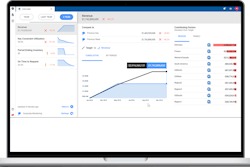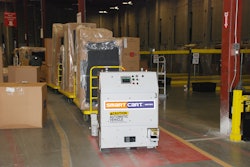![Getty Images 914835394 [converted]](https://img.sdcexec.com/files/base/acbm/sdce/image/2018/05/GettyImages_914835394__Converted_.5af5d5a071719.png?auto=format%2Ccompress&q=70&w=400)
Ask any factory manager their thoughts on the most important tech advancement of the last two decades, and you’re likely to get a similar answer: data capture. Moving processes away from error-prone pencil-and-paper recordkeeping immediately increases shop floor visibility and efficiency. Managers no longer need to manually track machine and labor productivity; they can interpret the information and adjust processes based on their findings.
While basic data capture had a major impact on factory processes when it was introduced, it still suffered from a significant flaw: it couldn’t keep up with the speed at which managers must interpret, absorb and then make decisions. If an important asset is days away from malfunctioning, that information must be readily available to the manager rather than buried in data. Industry 4.0, driven by machine learning and artificial intelligence (AI), has made strides in minimizing this delay in decision-making.
To demonstrate the impact of Industry 4.0 on shop floor processes, think of AI in the factory as a chess match. You’re the player, inefficiencies are your opponent and productivity is checkmate. With traditional data capture software, you’re only empowered to think about your next move. You have information about the factory floor’s current status and nothing more.
Today’s machine learning has already enabled factory managers to think one move ahead. Tomorrow’s developments, and ultimately the endgame for AI in the factory, could help us think two or even three moves ahead. Let’s take a deeper dive into the current state of factory AI, the developments we’re likely to see in the next 1-2 years, and what AI innovators hope the technology will be able to achieve in the not-too-distant future.
Today’s Machine Learning: One Move Ahead
The next step beyond simple data capture is recognizing patterns within that data without human aid—and machine learning has already achieved this step.
This rapid development is thanks in part to the Internet of Things (IoT). Whereas 5-10 years ago installing equipment to detect process anomalies would be expensive and time consuming, it’s now relatively simple and affordable to feed 100 sensors into your manufacturing execution system. These sensors “learn” your machinery’s normal state. Working together, sensors can detect patterns—such as those within vibrations—that deviate from this normal state and alert the maintenance crews and managers.
Sensor technology empowers us to stay one step ahead of inefficiency. Rather than dealing with malfunctioning equipment after it’s already affecting productivity, we now have “leading information,” or hints that something will go wrong soon. Managers then interpret this data and make adjustments with minimal effect on regular factory operations.
Still, today’s machine learning technology has its limits. Although it can sense coming malfunctions, it doesn’t recognize these signals as problems. Human operators must still add context to the data. In other words, you have an idea of how your opponent’s next move might play out, but you’ll have to know your opponent well to counter it. The next developments in machine learning will prepare you to counter your opponent’s next move.
Tomorrow’s Machine Learning: Two Moves Ahead
Current IoT technology drives business and logic—it collects the data, you examine it in the context of your factory’s normal operations and your team determines how to address potential pain points. As long as humans are required to intervene in the solution of these common factory issues, however, we won’t attain a truly automated shop floor.
Tomorrow’s technology needs to drive workflow. Specifically, it needs to determine whether countermeasures for common malfunctions are in place. For example, machine sensors might recognize that a specific set of vibrations signal a motor is reaching end-of-life. The factory manager wouldn’t have to interpret data to address it. Rather, these vibrations would trigger a search for another motor in stock. The manager is alerted to the issue, has a clear understanding of the fix and is advised on what steps they should take to address it.
We’re not far from a factory driven by this level of machine learning. In fact, we’re already seeing similar applications in the home, with Amazon’s Alexa and Apple’s Siri virtual assistants. The words that the devices hear trigger a reaction, bringing information back to the user. Of course, detecting machine malfunctions is slightly more complicated than checking movie showtimes. Innovators continue to develop and perfect this level of AI in the factory, and it’s not a stretch to say it could be widespread before the decade closes out.
Now we’re thinking two moves ahead. We’ve analyzed our opponents’ possible moves, and we know exactly how to counter them. But what about the bigger picture? What if we could analyze not just the pieces currently in play, but also factor in that rook or knight your opponent has yet to touch? That’s machine learning’s endgame.
Machine Learning’s Endgame: Three Moves Ahead
When you’re addressing shop floor inefficiencies, you’ll naturally try to correct internal issues first—aging equipment, for instance. These are the most visible issues, and fixing them is usually within your control.
However, external forces can have just as great an impact, if not greater, on your productivity. Perhaps it’s the height of flu season, and cases are skyrocketing in a community where many of your employees live. Maybe a hurricane impacted your supplier on the east coast, and you’re left without the materials necessary for production. Even if a disaster doesn’t directly affect your company, you might still feel the ripples.
AI innovators are thinking outside the physical factory and developing solutions that impact the entire factory ecosystem—the materials that move in and out of the factory, the employees who come to work each day and the community in which the factory operates. Much more advanced than sensors on the shop floor, these solutions will be integral for day-to-day operations. They’ll track all factors currently affecting factory performance and have protocols to minimize lost productivity. If a hurricane is 48 hours from affecting a major supplier, it could shift orders to another provider outside the storm’s path. It will identify areas of the warehouse that could be impacted by mass illness and prepare for a labor shortage. Data points as granular as the current air temperature will be tracked and operations adjusted accordingly.
Instead of thinking only about your opponent’s next move and how you’ll respond, you’ve considered all of your opponent’s pieces—even the ones that aren’t immediate threats—and figured out how they’ll play into your next few moves.
Advanced AI is no longer science fiction. Although it may not be ready to solve all of your company’s challenges, innovators get closer every day. That’s why it’s critical to consider how you might prepare your factory for rapidly evolving technology.
Strategies for Checkmate: Aiming for Maximum Productivity
If you’re still relying on manual data tracking to manage your factory, the thought of switching to automated processes can be daunting. So, where to begin? Consider these three steps:
- Determine the key variables that affect your operations. Before you invest in a new solution, ensure you understand which variables most affect factory productivity. Spend a day on the shop floor watching employees move through daily activities, and start an open dialogue concerning which tasks prevent them from working efficiently. Then consider how you might overlay those variables with IoT-enabled technology. Different solutions address different pain points, and you’ll want to make sure you understand what issues need to be addressed before you invest.
- Identify areas of potential rapid implementation. The longer you wait to address inefficiency, the more it hurts your bottom line. Determine which issues you can fix quickly, and prioritize new technology within those areas. Because IoT sensors are inexpensive and relatively easy to install, implementing new data collection software is generally a good first investment. However, make sure it aligns with your specific pain points.
- Integrate your technology into algorithms. AI requires an understanding of your processes before it can actively improve your factory. Determine how best your IoT-enabled technology can be programmed into algorithms to address common problems as they arise—and plan for slight variations on your pain points. Your solution must be able to recognize that two different vibrations could mean the same issue with your machinery.
One final piece of advice concerning implementation: avoid installing a solution on servers in-house. The equipment is costly, and you won’t have the power to quickly analyze sensor data. Instead, consider investing in a cloud-based AI solution. They’re much more powerful, able to turn around data analysis rapidly, and don’t require substantial upfront investments or lengthy implementations.
It’s Your Move
Addressing problems as they arise is no longer a sustainable business model. There are too many demands on the factory to allow for downtime. If you’d like to stay one step ahead of your pain points, or if you’d like to lay the foundation for an AI overhaul down the road, you’ll need to invest in today’s technology and empower your employees to work at maximum productivity. Only then will you be able to declare checkmate on inefficiency.













![Pros To Know 2026 [color]](https://img.sdcexec.com/mindful/acbm/workspaces/default/uploads/2025/08/prostoknow-2026-color.mduFvhpgMk.png?ar=16%3A9&auto=format%2Ccompress&bg=fff&fill-color=fff&fit=fill&h=135&q=70&w=240)


